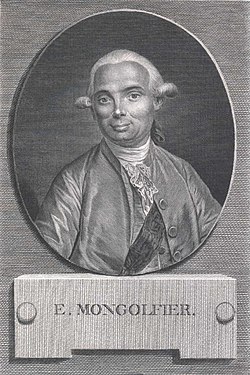Difference between revisions of "AY Honors/Hot Air Balloons/Answer Key"
(io) |
|||
| (6 intermediate revisions by the same user not shown) | |||
| Line 7: | Line 7: | ||
On [[December 14]], [[1782]] they succeeded in an outdoor launch of an 18 m³ silk bag, which reached an altitude of 250 m. | On [[December 14]], [[1782]] they succeeded in an outdoor launch of an 18 m³ silk bag, which reached an altitude of 250 m. | ||
| − | On [[June 5]], [[ | + | On [[June 5]], [[1782]], as a first public demonstration, they sent up at Annonay a 900 m linen bag inflated with hot air. Its flight covered 2 km, lasted 10 minutes, and had an estimated altitude of 1600 - 2000 m. |
The subsequent test sent up the first living beings in a basket attached to the balloon: a sheep, a duck and a cockerel, to ascertain the effects of the air at higher altitude. This was performed at [[Versailles]], before [[Louis XVI of France]], to gain his permission for a trial human flight. | The subsequent test sent up the first living beings in a basket attached to the balloon: a sheep, a duck and a cockerel, to ascertain the effects of the air at higher altitude. This was performed at [[Versailles]], before [[Louis XVI of France]], to gain his permission for a trial human flight. | ||
| Line 14: | Line 14: | ||
On [[November 21]], [[1783]], the first free flight by humans was made by [[Pilâtre de Rozier]] and [[Marquis d'Arlandes]] who flew aloft for 25 minutes about 100 metres above [[Paris]] for a distance of nine kilometres. | On [[November 21]], [[1783]], the first free flight by humans was made by [[Pilâtre de Rozier]] and [[Marquis d'Arlandes]] who flew aloft for 25 minutes about 100 metres above [[Paris]] for a distance of nine kilometres. | ||
| − | |||
| − | |||
Only one of the brothers (the exact one is unknown) ever flew himself in a balloon, and then only once. | Only one of the brothers (the exact one is unknown) ever flew himself in a balloon, and then only once. | ||
| Line 21: | Line 19: | ||
[[Hot air balloon]]s soon were superseded by [[hydrogen]] gas balloons and did not return until the [[1960s]] when [[Raven Industries]] improved the safety of the classic Montgolfier design by using ripstop nylon for the envelope and [[propane]] gas as the burner fuel. | [[Hot air balloon]]s soon were superseded by [[hydrogen]] gas balloons and did not return until the [[1960s]] when [[Raven Industries]] improved the safety of the classic Montgolfier design by using ripstop nylon for the envelope and [[propane]] gas as the burner fuel. | ||
| − | [[Category:1740 births | + | [[Category:1740 births]] |
| − | [[Category:1810 deaths | + | [[Category:1810 deaths]] |
| − | [[Category: | + | [[Category:Balloonists]] |
| − | [[Category: | + | [[Category:Multiple people]] |
| − | |||
[[de:Montgolfier]] | [[de:Montgolfier]] | ||
[[fr:Frères Montgolfier]] | [[fr:Frères Montgolfier]] | ||
[[io:Montgolfier frati]] | [[io:Montgolfier frati]] | ||
| − | [[he: | + | [[no:Brødrene Montgolfier]] |
| + | [[he:האחים מונגולפייה]] | ||
| + | [[pl:Bracia Montgolfier]] | ||
| + | [[sr:Браћа Монголфје]] | ||
[[fi:Montgolfierin veljekset]] | [[fi:Montgolfierin veljekset]] | ||
| − | |||
[[sv:Montgolfier]] | [[sv:Montgolfier]] | ||
| + | [[zh:孟格菲兄弟]] | ||
Revision as of 17:09, 8 October 2005
The Montgolfier brothers, Joseph Michel Montgolfier (August 26, 1740 – June 26, 1810) and Jacques Étienne Montgolfier (January 6, 1745 – August 2, 1799), inventors of the montgolfière hot air balloon.
The brothers were the sons of a paper manufacturer at Annonay, south of Lyon, France. When playing with inverted paper bags over open fire they found that the bags rose to the ceiling. This led them to experiment further with larger bags made of other materials. During 1782 they tested indoors with silk and linen.
On December 14, 1782 they succeeded in an outdoor launch of an 18 m³ silk bag, which reached an altitude of 250 m.
On June 5, 1782, as a first public demonstration, they sent up at Annonay a 900 m linen bag inflated with hot air. Its flight covered 2 km, lasted 10 minutes, and had an estimated altitude of 1600 - 2000 m.
The subsequent test sent up the first living beings in a basket attached to the balloon: a sheep, a duck and a cockerel, to ascertain the effects of the air at higher altitude. This was performed at Versailles, before Louis XVI of France, to gain his permission for a trial human flight.
An ascent in a fixed balloon took place around October 15 (12 or 14 according to Montgolfier), to an altitude of 26 m.
On November 21, 1783, the first free flight by humans was made by Pilâtre de Rozier and Marquis d'Arlandes who flew aloft for 25 minutes about 100 metres above Paris for a distance of nine kilometres.
Only one of the brothers (the exact one is unknown) ever flew himself in a balloon, and then only once.
Hot air balloons soon were superseded by hydrogen gas balloons and did not return until the 1960s when Raven Industries improved the safety of the classic Montgolfier design by using ripstop nylon for the envelope and propane gas as the burner fuel. de:Montgolfier fr:Frères Montgolfier io:Montgolfier frati no:Brødrene Montgolfier he:האחים מונגולפייה pl:Bracia Montgolfier sr:Браћа Монголфје fi:Montgolfierin veljekset sv:Montgolfier zh:孟格菲兄弟

